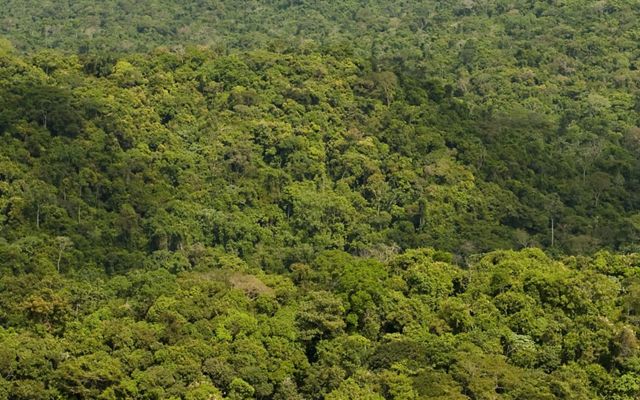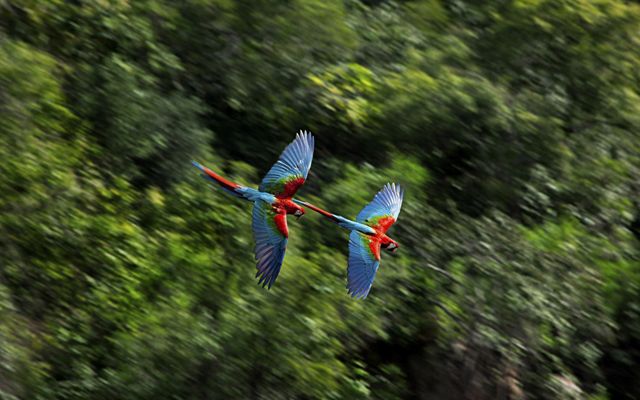Natural Climate Solutions
Natural climate solutions offer immediate and cost-effective ways to tackle the climate crisis—while also supporting healthy, thriving communities and ecosystems.

Valuing Standing Forests and Rewarding Nature Stewards in the Amazon
Forests matter. They absorb approximately 2.4 billion metric tons of carbon every year and help to regulate our climate. Moreover, it is estimated that forests directly generate USD $250 billion in economic activity annually and USD $100 trillion per year when accounting for their carbon sequestration potential. That is equivalent to the world’s annual gross domestic product.
The Amazon rainforest is the largest remaining tropical forest on our planet. It is home to 1/4 of the world’s species; 1/5 of the world’s fresh water; 2/5 of the world’s tropical forests; and more than 350 Indigenous and traditional communities. Nearly the size of the continental United States, the Amazon spans nine countries (Brazil, Peru, Bolivia, Ecuador, Colombia, Venezuela, French Guiana, Guyana, Suriname).
Get our latest research, perspectives and solutions to today’s sustainability challenges.
Sign UpYet this vital ecosystem is at risk. In 2024, wildfires in Latin America fueled by climate change wiped out an area the size of Costa Rica. These fires released an estimated 1.15 gigatonnes of carbon dioxide into the atmosphere, more than all the carbon emissions from fossil fuel use in South America in 2023.
For now, the Amazon acts as a vast carbon storage area, binding up 650 billion tons of carbon dioxide in its trees. If we lose those trees, all of that carbon would enter the world’s atmosphere and further contribute to climate change. Because of this, there is a growing sense of urgency that the Amazon may soon reach a tipping point—shifting from a carbon sink to a net source of carbon emissions.
There are many areas within the Amazon classified as “High-Forest, Low Deforestation” (HFLD)—in other words, places with lots of intact forest which have historically experienced minimal disturbance. While these HFLD areas represent a small proportion of the world’s remaining forests, their impact on climate regulation is disproportionate: They have accumulated large amounts of “irrecoverable carbon” stocks over centuries; they make up a majority of the land-based ecosystems that absorb 30% of human global emissions each year; and they help cool the Earth’s surface.


Many Indigenous Peoples and Local Communities (IP & LCs) live within the Amazon’s HFLD areas. They are some of the best stewards of the planet’s land and water—especially when equipped with strong tenure, land rights and direct access to funding. In the Amazon alone, Indigenous Peoples manage more than 30% of the rainforest, and satellite images show that deforestation in Indigenous territories is nearly 50% lower than in similar surrounding lands.
And yet, despite the immense global importance of forests and those who inhabit them, the amount of funding channelled to these areas is limited. Current financial flows fall far short of the estimated USD $460 billion needed annually to halt and reverse deforestation and forest degradation by 2030. Furthermore, of the total available amount of funding that flows to forests, less than 2% goes directly to IP & LCs.
HFLD regions and their inhabitants should be rewarded for their stewardship of carbon and biodiversity. However, a significant portion of available funding has historically been directed exclusively toward areas experiencing high rates of deforestation, focusing on reducing emissions from forest loss. This has resulted in few dedicated finance opportunities for HFLD areas and its inhabitants. This funding imbalance creates a perversive incentive: If financial rewards are tied only to halting active deforestation, it can inadvertently encourage forest loss as a means to qualify for funding.
One solution is complementary financing mechanisms that recognize and reward communities in HFLD areas for keeping their forests intact. The proposed Tropical Forest Forever Facility (TFFF) is one example. Spearheaded by the Brazilian government, this initiative aims to provide long-term, reliable funding for the world's tropical forests. The program would reward countries based on their success in conserving HFLD and other forest ecosystems. Crucially, it emphasizes the importance of including Indigenous Peoples and Local Communities, mandating that at least 20% of the funds be allocated directly to them. This ensures that those who are protecting this natural heritage receive meaningful support.
While the TFFF still requires refinement, particularly in aligning with existing mechanisms like REDD+, its emphasis on support from the Global South and a new approach to incentives give it strong potential. Instead of focusing solely on reducing deforestation, the TFFF aims to reward Tropical Forest Countries (TFCs) for their conservation efforts, offering a new way to value and finance forest stewardship.

Crucially, it emphasizes the importance of including Indigenous Peoples and Local Communities, mandating that at least 20% of the funds be allocated directly to them. This ensures that those who are protecting this natural heritage receive meaningful support.
At The Nature Conservancy (TNC), we recognize the critical role of forests and especially the relatively neglected HFLD areas. We also recognize the necessity of supportive financing to keep these forests standing. We have assessed more than 14 different ideas to scale up finance for HFLD areas. We also recognize the urgent and critical need to channel funding directly to Indigenous Peoples and Local Communities.
In the Amazon, we have been building partnerships and trust with Indigenous organizations and territories for more than 25 years. Collectively, we are supporting them to bring down cultural, operational and financial barriers and develop promising Indigenous-led funding mechanisms that support stewardship and diversify livelihoods. This elevates communities to implement their own climate solutions, build self-determination, protect their rights and safeguard the forests that benefit us all. It also helps recognize and reward communities’ ways of life while creating the enabling and living conditions for them to thrive in place and lead community-driven conservation.
As we celebrate Amazon Week this June in cities across Europe, we take this moment to highlight our collective support of these innovative financial mechanisms. It is not only an environmental and climate imperative; it's an investment in the people who steward our forests and an important step toward a more equitable, resilient future for all.
Sign up to receive our Global Insights newsletter and other select content for thought leaders who believe that, together, we can build a better future for people and the planet. We address the sustainability issues of the moment and explore potential solutions—all in a five-minute read or less.

Combined with cutting fossil fuels and accelerating renewable energy, natural climate solutions offer immediate and cost-effective ways to tackle the climate crisis—while also addressing biodiversity loss and supporting human health and livelihoods.